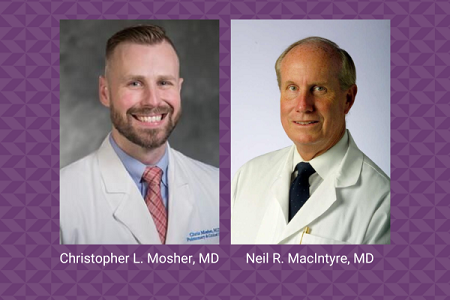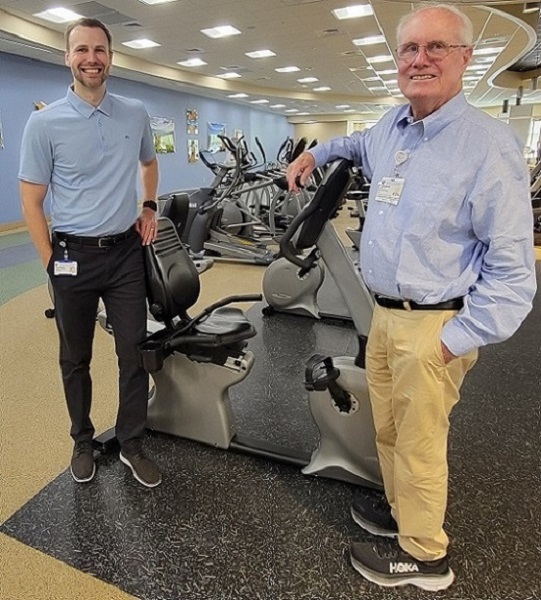
Pulmonary rehabilitation has come a long way as a treatment modality for patients with chronic lung diseases, significantly improving their quality of life and lifespan through exercise, education and psychosocial empowerment.
Duke’s Pulmonary Rehabilitation program—one of the oldest, largest, and most influential in the country—has been at the forefront of this progress since its inception in 1985 by longtime Duke Pulmonary Rehabilitation Medical Director Dr. Neil R. MacIntyre, who has played a pioneering role in the development of pulmonary rehabilitation as a one of the most effective treatments for patients with chronic lung diseases.
Dr. MacIntyre’s early studies looking at pulmonary rehabilitation demonstrated important improvements in exercise capacity, health related quality of life and substantial reductions in hospital admissions. These findings have been corroborated by many subsequent studies conducted across the globe. The international Cochrane Library of clinical trials recently concluded that the evidence supporting pulmonary rehabilitation efficacy was so strong that further trials were no longer needed.
As the supportive evidence base grew in the latter decades of the 20th century, Dr. MacIntyre and colleagues were active in the formation of many national pulmonary rehabilitation oversight bodies such as the American Association of Cardiovascular and Pulmonary Rehabilitation (AACVPR) and dedicated pulmonary rehabilitation sections in major pulmonary professional organizations.
The Duke Program
The first pulmonary rehabilitation class at Duke had two patient participants. Forty years and 4,000 patients later, there’s a waiting list. The program is also open to pre- and -post-op lung transplant recipients.
“The thing I’d say we are most proud of is the world-class staff, who demonstrate expertise, kindness, and compassion when caring for patients at our rehabilitation center,” Mosher said, referring to the Duke Cardiopulmonary Rehabilitation Team at Croasdaile facility, located in Durham.

An acknowledgement of the excellent care provided, the center has been fortunate to receive two endowments designed specifically for patients who cannot afford to participate.
“The patients we serve can be a particularly vulnerable group,” Mosher said. “They either don't have access to an exercise facility, or their local gym is unable to meet their high oxygen requirements during exercise. So, we've been supporting those patients who demonstrate a qualified financial need, and essentially making our maintenance program almost free for them to allow them to have access to the facility.”
The core “intensive” Duke Pulmonary Rehabilitation Program is five days a week for four and a half weeks, a concentrated time span to accommodate patients required to travel great distances. Those completing the core program can then participate in the “graduate” program, a less formal educational and supervised program designed to last a lifetime. A specialized rehabilitation program is also offered to lung transplant patients to help them prepare for surgery and recover afterwards. The teams include respiratory therapist, physical therapists specialized in cardiopulmonary rehabilitation, physical therapy assistants, a dietician and a mental health counselor.
Challenges for the Future
As leadership of the program transitions to Dr. MacIntyre’s mentee, new Medical Director Dr. Chris L. Mosher, Duke continues to build on its longstanding leadership record with Dr. Mosher following in his mentor’s outsized footsteps to tackle the biggest challenges to chronic disease management.
Chief among them are setting appropriate payer reimbursements to make pulmonary rehabilitation affordable for all patients with chronic lung diseases like chronic obstructive pulmonary disease (COPD), a leading cause of mortality that affects an estimated 24 million people in the United States.
Medicare in the U.S. is the major payer for older adults with chronic lung disease, but it was not until 2010 that pulmonary rehabilitation was finally recognized as a Medicare benefit. Yet despite consistent, strong evidence demonstrating its benefits, recognition as a safe, effective treatment by payers has remained elusive with all of Medicare’s policy nuances.
“Chris is doing a wonderful job of building on our past with his work showing the cost effectiveness of this kind of therapy,” said Dr. MacIntyre, an internationally recognized expert in respiratory life support and mechanical ventilation, and a professor in the division of Pulmonary, Allergy and Critical Care and “He’s taking our analyses to a higher level.”
Dr. Mosher, who assumed his new role in July 2023, said that direct health system costs associated with COPD are estimated at $800 billion over the next 20 years, more than 25% of which are attributable to hospitalization for COPD exacerbation.
If all fee-for-service COPD Medicare beneficiaries participated in pulmonary rehabilitation after a COPD hospitalization, he said, Medicare could save up to $1 billion annually. The prevalence of Americans with COPD among Medicare beneficiaries is 17%, yet participation in this therapy is estimated to be less than 5% of Medicare-eligible patients living with COPD.
Dr. Mosher further found that pulmonary rehabilitation after COPD hospitalization saves an estimated $5,700 per patient over their lifetime due to fewer hospitalizations and skilled nursing facility days.
Reimbursement remains one of Dr. Mosher’s chief priorities as he builds on his mentor’s work along with improving access to rehabilitation services, improving program components, and integrating pulmonary rehabilitation into overall managed care strategies.
Dr. Mosher is advocating for payers—particularly Medicare—to identify policies that would increase access and adherence to pulmonary rehabilitation programs.
“Considering the proven, substantial benefits of pulmonary rehabilitation, failure to facilitate participation in this high-value, cost-saving intervention should now be considered financially irresponsible, given the cost savings associated with participation,” Dr. Mosher said. “Payers, particularly Medicare, should leverage existing accountable care organizations and Medicare Advantage partnerships to identify policies that increase participation for patients living with COPD.”
Collaborative strategies facilitating substantive improvement in pulmonary rehabilitation reimbursement and participation must involve clinical, healthcare policy, and finance perspectives to effectively impact what undermines improvement in health status and clinical outcomes, Mosher explained.
Clinicians, legislators, and the public should ask themselves: When will patients living with COPD join the ranks of those with other chronic illnesses, in particular, heart disease, to have highly effective, safe, and cost-saving intervention? he added.
The Next Frontier
Telehealth pulmonary rehabilitation is the next frontier, Drs. Mosher and MacIntyre said, and in the coming years there will be an increased demand for options beyond traditional center-based pulmonary rehabilitation access. The Duke program has been involved in studies examining effectiveness of telehealth programs and Mosher plans for Duke to play a leading role in advocating that there are no dilutions in standards and outcomes achieved by participants.
Home-based, telehealth programs with clinical supervision may be an important way to address access barriers, he added.
A second area of future development is to extend programs to include non-COPD populations. Chronic lung disease has many causes but functional loss can be addressed by many of the pulmonary rehabilitation features used for COPD—especially supervised exercise.
A third area of needed development is for better integration into health system managed care programs. Pulmonary rehabilitation, he added, should be part of the overall strategy of chronic lung disease management that includes assessments, medication/device management, monitoring, self-care algorithms, hotlines with human operators, and appropriate reimbursement from payers .
“In the ICU you're working with machines, physiology and complicated drug regimens to make people better,” Dr. MacIntyre said. “In rehab you're working with the patient, him or herself to make themselves better. Pulmonary rehab is not just a program. It's a lifestyle and it's not just something that lasts four weeks. If you can successfully get patients to change their lifestyle to something along the lines of what they learn in pulmonary rehabilitation, you do a great deal of good for them in terms of function, in terms of just quality of life.”